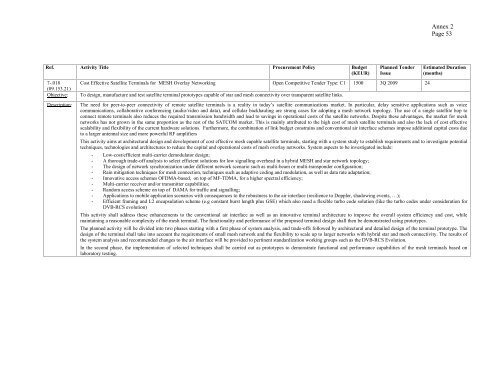ARTES-5.1 â ESA Telecom Technology Workplan ... - Emits - ESA
ARTES-5.1 â ESA Telecom Technology Workplan ... - Emits - ESA
ARTES-5.1 â ESA Telecom Technology Workplan ... - Emits - ESA
- No tags were found...
Create successful ePaper yourself
Turn your PDF publications into a flip-book with our unique Google optimized e-Paper software.
Annex 2Page 53Ref. Activity Title Procurement Policy Budget(KEUR)7-.018(09.153.21)Objective:Description:Planned TenderIssueCost Effective Satellite Terminals for MESH Overlay Networking Open Competitive Tender Type: C1 1500 3Q 2009 24To design, manufacture and test satellite terminal prototypes capable of star and mesh connectivity over transparent satellite links.Estimated Duration(months)The need for peer-to-peer connectivity of remote satellite terminals is a reality in today’s satellite communications market. In particular, delay sensitive applications such as voicecommunications, collaborative conferencing (audio/video and data), and cellular backhauling are strong cases for adopting a mesh network topology. The use of a single satellite hop toconnect remote terminals also reduces the required transmission bandwidth and lead to savings in operational costs of the satellite networks. Despite these advantages, the market for meshnetworks has not grown in the same proportion as the rest of the SATCOM market. This is mainly attributed to the high cost of mesh satellite terminals and also the lack of cost effectivescalability and flexibility of the current hardware solutions. Furthermore, the combination of link budget constrains and conventional air interface schemes impose additional capital costs dueto a larger antennal size and more powerful RF amplifiersThis activity aims at architectural design and development of cost effective mesh capable satellite terminals, starting with a system study to establish requirements and to investigate potentialtechniques, technologies and architectures to reduce the capital and operational costs of mesh overlay networks. System aspects to be investigated include:- Low-cost/efficient multi-carrier demodulator design;- A thorough trade-off analysis to select efficient solutions for low signalling overhead in a hybrid MESH and star network topology;- The design of network synchronization under different network scenario such as multi-beam or multi-transponder configuration;- Rain mitigation techniques for mesh connection, techniques such as adaptive coding and modulation, as well as data rate adaptation;- Innovative access schemes OFDMA-based, on top of MF-TDMA, for a higher spectral efficiency;- Multi-carrier receiver and/or transmitter capabilities;- Random access scheme on top of DAMA for traffic and signalling;- Applications to mobile application scenarios with consequences to the robustness to the air interface (resilience to Doppler, shadowing events, …);- Efficient framing and L2 encapsulation scheme (e.g constant burst length plus GSE) which also need a flexible turbo code solution (like the turbo codes under consideration forDVB-RCS evolution)This activity shall address these enhancements to the conventional air interface as well as an innovative terminal architecture to improve the overall system efficiency and cost, whilemaintaining a reasonable complexity of the mesh terminal. The functionality and performance of the proposed terminal design shall then be demonstrated using prototypes.The planned activity will be divided into two phases starting with a first phase of system analysis, and trade-offs followed by architectural and detailed design of the terminal prototype. Thedesign of the terminal shall take into account the requirements of small mesh network and the flexibility to scale up to larger networks with hybrid star and mesh connectivity. The results ofthe system analysis and recommended changes to the air interface will be provided to pertinent standardization working groups such as the DVB-RCS Evolution.In the second phase, the implementation of selected techniques shall be carried out as prototypes to demonstrate functional and performance capabilities of the mesh terminals based onlaboratory testing.
















